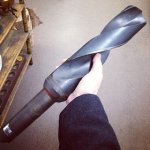Sounds like you've tried just about everything. I think that if there was enough stud sticking out to weld a nut on it you would have already tried that. Even then, you will still have the original problem of the stuck threads. I think that the only option you have now, if you are doing this at home, is to drill it out. Grind it down flush with the surface. This leaves a clean circle such that you can easily determine the center point of the stud. Take a center punch and lightly tap it to make a divot in the center of the stud. Once you are comfortable with the location of the divot, strike it harder to make it larger. Next, take a drill bit that is almost the same size as the base diameter of the stud and drill straight thru. If you have a really good drill press you can place the block in a vise and drill it straight. My drill press wobbles so badly that I could do a better job free handed. It is helpful to brace the block someway, perhaps bolt it down. The objective is to drill out almost everything but the threads while trying not to damage the threads in the aluminum (I assume it is aluminum). Once you have drilled thru the stud, take a pick and start working out the threads. If you are lucky, once you have drilled out the center the outer threads will relax enough to start turning. If it is an aluminum block, the threads won't be bonded to the aluminum and should come out freely. If the block is cast iron you will have a more difficult time with it. If you damage the threads slightly with the drill bit it will not be a problem. However, if you get off center and damage them badly you may have to go the heli-coil route to fix it. If you still have good threads 80% of the way around the hole it will still work. Nothing is going to leak out. One good stud and one questionable stud is better than just one good stud. You asked if you need two bolts. I think you do, but the motor will run with a leaky muffler or no muffler at all. Some motor blocks have the two threaded holes for a flange plus have pipe threads in the hole for a screw in muffler. Or if the hole is round you might be able to thread the inside with a pipe tap and buy a screw in muffler. HF has the large pipe taps. I bought a set. Good luck with it.

